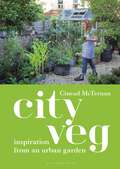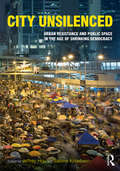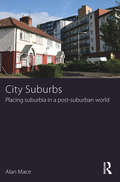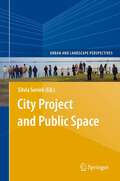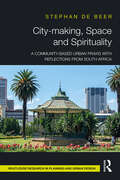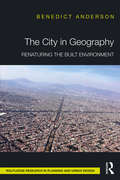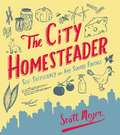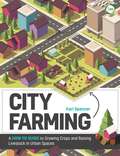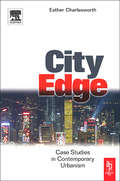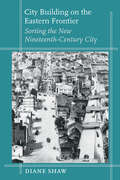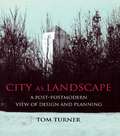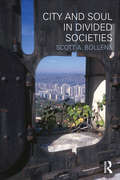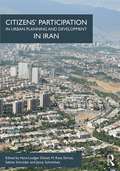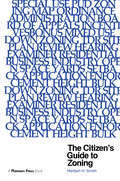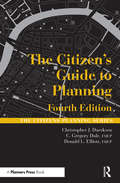- Table View
- List View
City Veg: Inspiration from an Urban Garden
by Cinead McTernanGrowing your own vegetables is good for your health, the environment and even your wallet! And eating a plant-based diet – whether you're a vegan, vegetarian or are just trying to eat more greens - is gaining popularity as a sensible, healthy solution to combat obesity and as a way of caring for the planet. More and more of us are looking to grow some of our own fruit and vegetables and be more mindful by choosing seasonal ingredients. Written over a year, City Veg is the candid account of an urban grower from her own productive city plot, with all the triumphs and minor woes that go hand-in-hand with a small, suburban location. From planning and designing her garden in January to harvesting and using her home-grown produce throughout the growing season and right up until December, City Veg takes readers on a personal journey that will entertain experienced growers while sharing plenty of practical information to help newbie growers get off to a great start.Packed with growing advice, monthly harvesting guides, tips and simple projects, and quick and easy recipe ideas to accompany growing themes.
City Unsilenced: Urban Resistance and Public Space in the Age of Shrinking Democracy
by Jeffrey Hou Sabine KnierbeinWhat do the recent urban resistance tactics around the world have in common? What are the roles of public space in these movements? What are the implications of urban resistance for the remaking of public space in the "age of shrinking democracy"? To what extent do these resistances move from anti- to alter-politics? City Unsilenced brings together a cross-disciplinary group of scholars and scholar-activists to examine the spaces, conditions, and processes in which neoliberal practices have profoundly impacted the everyday social, economic, and political life of citizens and communities around the globe. They explore the commonalities and specificities of urban resistance movements that respond to those impacts. They focus on how such movements make use of and transform the meanings and capacity of public space. They investigate their ramifications in the continued practices of renewing democracies. A broad collection of cases is presented and analyzed, including Movimento Passe Livre (Brazil), Google Bus Blockades San Francisco (USA), the Platform for Mortgage Affected People (PAH) (Spain), the Piqueteros Movement (Argentina), Umbrella Movement (Hong Kong), post-Occupy Gezi Park (Turkey), Sunflower Movement (Taiwan), Occupy Oakland (USA), Syntagma Square (Greece), Researchers for Fair Policing (New York), Urban Movement Congress (Poland), urban activism (Berlin), 1DMX (Mexico), Miyashita Park Tokyo (Japan), 15M Movement (Spain), and Train of Hope and protests against Academic Ball in Vienna (Austria). By better understanding the processes and implications of the recent urban resistances, City Unsilenced contributes to the ongoing debates concerning the role and significance of public space in the practice of lived democracy.
City Unsilenced: Urban Resistance and Public Space in the Age of Shrinking Democracy
by Jeffrey Hou Sabine KnierbeinWhat do the recent urban resistance tactics around the world have in common? What are the roles of public space in these movements? What are the implications of urban resistance for the remaking of public space in the "age of shrinking democracy"? To what extent do these resistances move from anti- to alter-politics? City Unsilenced brings together a cross-disciplinary group of scholars and scholar-activists to examine the spaces, conditions, and processes in which neoliberal practices have profoundly impacted the everyday social, economic, and political life of citizens and communities around the globe. They explore the commonalities and specificities of urban resistance movements that respond to those impacts. They focus on how such movements make use of and transform the meanings and capacity of public space. They investigate their ramifications in the continued practices of renewing democracies. A broad collection of cases is presented and analyzed, including Movimento Passe Livre (Brazil), Google Bus Blockades San Francisco (USA), the Platform for Mortgage Affected People (PAH) (Spain), the Piqueteros Movement (Argentina), Umbrella Movement (Hong Kong), post-Occupy Gezi Park (Turkey), Sunflower Movement (Taiwan), Occupy Oakland (USA), Syntagma Square (Greece), Researchers for Fair Policing (New York), Urban Movement Congress (Poland), urban activism (Berlin), 1DMX (Mexico), Miyashita Park Tokyo (Japan), 15M Movement (Spain), and Train of Hope and protests against Academic Ball in Vienna (Austria). By better understanding the processes and implications of the recent urban resistances, City Unsilenced contributes to the ongoing debates concerning the role and significance of public space in the practice of lived democracy.
City Suburbs: Placing suburbia in a post-suburban world
by Alan MaceThe majority of the world’s population is now urban, and for most this will mean a life lived in the suburbs. City Suburbs considers contemporary Anglo-American suburbia, drawing on research in outer London it looks at life on the edge of a world city from the perspective of residents. Interpreted through Bourdieu’s theory of practice it argues that the contemporary suburban life is one where place and participation are, in combination, strong determinants of the suburban experience. From this perspective suburbia is better seen as a process, an on-going practice of the suburban which is influenced but not determined by the history of suburban development. How residents engage with the city and the legacy of particular places combine powerfully to produce very different experiences across outer London. In some cases suburban residents are able to combine the benefits of the city and their residential location to their advantage but in marginal middle-class areas the relationship with the city is more circumspect as the city represents more threat than opportunity. The importance of this relational experience with the city informs a call to integrate more fully the suburbs into studies of the city.
City Suburbs: Placing suburbia in a post-suburban world
by Alan MaceThe majority of the world’s population is now urban, and for most this will mean a life lived in the suburbs. City Suburbs considers contemporary Anglo-American suburbia, drawing on research in outer London it looks at life on the edge of a world city from the perspective of residents. Interpreted through Bourdieu’s theory of practice it argues that the contemporary suburban life is one where place and participation are, in combination, strong determinants of the suburban experience. From this perspective suburbia is better seen as a process, an on-going practice of the suburban which is influenced but not determined by the history of suburban development. How residents engage with the city and the legacy of particular places combine powerfully to produce very different experiences across outer London. In some cases suburban residents are able to combine the benefits of the city and their residential location to their advantage but in marginal middle-class areas the relationship with the city is more circumspect as the city represents more threat than opportunity. The importance of this relational experience with the city informs a call to integrate more fully the suburbs into studies of the city.
City Project and Public Space (Urban and Landscape Perspectives #14)
by Silvia SerreliThe book aims at nurturing theoretic reflection on the city and the territory and working out and applying methods and techniques for improving our physical and social landscapes. The main issue is developed around the projectual dimension, with the objective of visualising both the city and the territory from a particular viewpoint, which singles out the territorial dimension as the city’s space of communication and negotiation. Issues that characterise the dynamics of city development will be faced, such as the new, fresh relations between urban societies and physical space, the right to the city, urban equity, the project for the physical city as a means to reveal civitas, signs of new social cohesiveness, the sense of contemporary public space and the sustainability of urban development. Authors have been invited to explore topics that feature a pluralism of disciplinary contributions studying formal and informal practices on the project for the city and seeking conceptual and operative categories capable of understanding and facing the problems inherent in the profound transformations of contemporary urban landscapes.
City-making, Space and Spirituality: A Community-Based Urban Praxis with Reflections from South Africa
by Stéphan de BeerThis book is about the soul of the city, embodied in its spaces and people. It traces dynamics in inner city neighbourhoods of South Africa’s post-apartheid capital, Pretoria. Viewing the city through its most vulnerable people and places, it recognizes that urban space is never neutral and shaped by competing value frameworks. The first part of the book invites planners, city-makers, and ordinary urban citizens, to consider a new self-understanding, reclaiming their agency in the city-making process. Through the metaphor of "becoming like children", planning practice is deconstructed and re-imagined. A praxis-based methodology is presented, cultivating four distinct moments of entering, reading, imagining and co-constructing the city. After deconstructing urban spaces and discourses, the second part of the book explores a concrete spirituality and ethic of urban space. It argues for a shift from planning as technocracy, to planning as immersed, participatory artistry: opening up to the "genius" of space, responsive to urban cries, and joining to construct new, soul-full spaces. Local communities and interconnected movements become embodiments of urban alternatives – through resistance and reconstruction; building on local assets; animating local reclamations; and weaving nets of hope that will span the entire city. Providing a concrete methodology for city-making that is rooted in a community-based urban praxis, this book will be of interest to urban planning researchers, professional planners and designers and also grass-root community developers or activists.
City-making, Space and Spirituality: A Community-Based Urban Praxis with Reflections from South Africa
by Stéphan de BeerThis book is about the soul of the city, embodied in its spaces and people. It traces dynamics in inner city neighbourhoods of South Africa’s post-apartheid capital, Pretoria. Viewing the city through its most vulnerable people and places, it recognizes that urban space is never neutral and shaped by competing value frameworks. The first part of the book invites planners, city-makers, and ordinary urban citizens, to consider a new self-understanding, reclaiming their agency in the city-making process. Through the metaphor of "becoming like children", planning practice is deconstructed and re-imagined. A praxis-based methodology is presented, cultivating four distinct moments of entering, reading, imagining and co-constructing the city. After deconstructing urban spaces and discourses, the second part of the book explores a concrete spirituality and ethic of urban space. It argues for a shift from planning as technocracy, to planning as immersed, participatory artistry: opening up to the "genius" of space, responsive to urban cries, and joining to construct new, soul-full spaces. Local communities and interconnected movements become embodiments of urban alternatives – through resistance and reconstruction; building on local assets; animating local reclamations; and weaving nets of hope that will span the entire city. Providing a concrete methodology for city-making that is rooted in a community-based urban praxis, this book will be of interest to urban planning researchers, professional planners and designers and also grass-root community developers or activists.
The City in Geography: Renaturing the Built Environment
by Benedict AndersonMonumental in scale and epic in development, cities have become the most visible and significant symbol of human progress. The geography on and around which they are constructed, however, has come to be viewed merely in terms of its resources and is often laid to waste once its assets have been stripped. The City in Geography is an urban exploration through this phenomenon, from settlement to city through physical geography, which reveals an incremental progression of removing terrain, topography and geography from the built environment, ushering in and advancing global destruction and instability. This book explains how the fall of geography in relationship to human survival has come through the loss of contact between urban dwellers and physical terrain, and details the radical rethinking required to remedy the separations between the city, its inhabitants and the landscape upon which it was built.
The City in Geography: Renaturing the Built Environment
by Benedict AndersonMonumental in scale and epic in development, cities have become the most visible and significant symbol of human progress. The geography on and around which they are constructed, however, has come to be viewed merely in terms of its resources and is often laid to waste once its assets have been stripped. The City in Geography is an urban exploration through this phenomenon, from settlement to city through physical geography, which reveals an incremental progression of removing terrain, topography and geography from the built environment, ushering in and advancing global destruction and instability. This book explains how the fall of geography in relationship to human survival has come through the loss of contact between urban dwellers and physical terrain, and details the radical rethinking required to remedy the separations between the city, its inhabitants and the landscape upon which it was built.
The City Homesteader: Self-Sufficiency on Any Square Footage
by Scott MeyerThe City Homesteader is the handbook for the world of self-sufficient living. It's about living tangibly in a virtual world. It's about being resourceful, saving money, reducing consumption, and increasing self-reliance. Join the many who are raising backyard chickens in the city and tilling their side yards: tapping into natural energy, managing homes more efficiently, and getting back to the earth. Explore the homesteading arts: gardening on small and large scales, raising dwarf fruit trees, sprouting grains, smoking meats and fish, grinding grains for flour, making cheese, making wine, cellaring, heating without fossil fuel, harvesting rainwater, composting, and much moreThe City Homesteader provides all the basics, including how to find supplies and step-by-step instructions that make it easy to follow along. Original illustrations throughout help you create your very own homestead on any piece of earth.
City Farming: A How-to Guide To Growing Crops And Raising Livestock In Urban Spaces (PDF)
by Kari SpencerFarming in cities and small spaces is becoming increasingly popular, but it has its challenges. City Farming addresses the problems the urban farmer might face and turns them into creative solutions. It assists the new grower to gain expert understanding of how to create a production urban farm, as well as helping established farmers to troubleshoot and discover new ways to bring their space into greater harmony and production. From the perspective of a holistic gardener, growing plants and raising livestock are covered as well as integrated approaches, which bring together the whole farming system in a small space to produce high yields with minimal energy and effort.The content is organised by themes of importance to urban farmers - sun and heat, water usage, seasonal production, spatial planning, soil quality and usage, propagation and breeding, pests and diseases, farming under time constraints, sustainability and community initiatives. These are all discussed within the context of urban farming and include common issues and strategies like microclimates in built-up areas, natural and organic approaches, water harvesting, toxic land, roof gardening, converting ornamental gardens to productive edible gardens, municipal regulations, vertical gardening, aquaponics, composting methods, livestock suitability in limited space, Community Supported Agriculture (CSA) schemes, permaculture in small spaces, community gardens and trade & barter schemes.Each chapter unfolds a piece the story of The Micro Farm Project that provides an overview of the theme, and then discusses the crop and livestock considerations relating to the theme of the chapter in the form of the challenges they present and practical solutions to the problems such as lack of space, high population density, poor soil quality, planning restrictions etc. Case studies giving examples of different methods used within urban farming from different regions throughout the world are included.City Farming is a beautifully illustrated source that can be valuable to both beginners and more experienced urban farmers.
City Farming: A How-to Guide To Growing Crops And Raising Livestock In Urban Spaces
by Kari SpencerFarming in cities and small spaces is becoming increasingly popular, but it has its challenges. City Farming addresses the problems the urban farmer might face and turns them into creative solutions. It assists the new grower to gain expert understanding of how to create a production urban farm, as well as helping established farmers to troubleshoot and discover new ways to bring their space into greater harmony and production. From the perspective of a holistic gardener, growing plants and raising livestock are covered as well as integrated approaches, which bring together the whole farming system in a small space to produce high yields with minimal energy and effort.The content is organised by themes of importance to urban farmers - sun and heat, water usage, seasonal production, spatial planning, soil quality and usage, propagation and breeding, pests and diseases, farming under time constraints, sustainability and community initiatives. These are all discussed within the context of urban farming and include common issues and strategies like microclimates in built-up areas, natural and organic approaches, water harvesting, toxic land, roof gardening, converting ornamental gardens to productive edible gardens, municipal regulations, vertical gardening, aquaponics, composting methods, livestock suitability in limited space, Community Supported Agriculture (CSA) schemes, permaculture in small spaces, community gardens and trade & barter schemes.Each chapter unfolds a piece the story of The Micro Farm Project that provides an overview of the theme, and then discusses the crop and livestock considerations relating to the theme of the chapter in the form of the challenges they present and practical solutions to the problems such as lack of space, high population density, poor soil quality, planning restrictions etc. Case studies giving examples of different methods used within urban farming from different regions throughout the world are included.City Farming is a beautifully illustrated source that can be valuable to both beginners and more experienced urban farmers.
City Edge
by Esther CharlesworthThis series of essays outlines a number of case studies from Europe, North America, Australia and Asia and provides first hand accounts of the experiences that planners, architects and politicians have had in reshaping cities. These insights provide a pragmatic assessment of the challenges and constraints posed by changing patterns of urban growth in a broad spectrum of urban environments. The reader will discover, through these multiple voices and views, the diverse forms of global cities, and will have a grasp of where the debate on urban design stands today, and where it may be going in the future.
City Edge
by Esther CharlesworthThis series of essays outlines a number of case studies from Europe, North America, Australia and Asia and provides first hand accounts of the experiences that planners, architects and politicians have had in reshaping cities. These insights provide a pragmatic assessment of the challenges and constraints posed by changing patterns of urban growth in a broad spectrum of urban environments. The reader will discover, through these multiple voices and views, the diverse forms of global cities, and will have a grasp of where the debate on urban design stands today, and where it may be going in the future.
City Building on the Eastern Frontier: Sorting the New Nineteenth-Century City (Creating the North American Landscape)
by Diane ShawAmerica's westward expansion involved more than pushing the frontier across the Mississippi toward the Pacific; it also consisted of urbanizing undeveloped regions of the colonial states. In 1810, New York's future governor DeWitt Clinton marveled that the "rage for erecting villages is a perfect mania." The development of Rochester and Syracuse illuminates the national experience of internal economic and cultural colonization during the first half of the nineteenth century. Architectural historian Diane Shaw examines the ways in which these new cities were shaped by a variety of constituents—founders, merchants, politicians, and settlers—as opportunities to extend the commercial and social benefits of the market economy and a merchant culture to America's interior. At the same time, she analyzes how these priorities resulted in a new approach to urban planning.According to Shaw, city founders and residents deliberately arranged urban space into three segmented districts—commercial, industrial, and civic—to promote a self-fulfilling vision of a profitable and urbane city. Shaw uncovers a distinctly new model of urbanization that challenges previous paradigms of the physical and social construction of nineteenth-century cities. Within two generations, the new cities of Rochester and Syracuse were sorted at multiple scales, including not only the functional definition of districts, but also the refinement of building types and styles, the stratification of building interiors by floor, and even the coding of public space by class, gender, and race. Shaw's groundbreaking model of early nineteenth-century urban design and spatial culture is a major contribution to the interdisciplinary study of the American city.
City as Landscape: A Post Post-Modern View of Design and Planning
by Tom TurnerIn twenty essays, this book covers aspects of planning, architecture, urban design, landscape architecture, park and garden design. Their approach, described as post-postmodern, is a challenge to the 'anything goes' eclecticism of the merely postmodern.
City as Landscape: A Post Post-Modern View of Design and Planning
by Tom TurnerIn twenty essays, this book covers aspects of planning, architecture, urban design, landscape architecture, park and garden design. Their approach, described as post-postmodern, is a challenge to the 'anything goes' eclecticism of the merely postmodern.
City and Soul in Divided Societies (Planning, History and Environment Series)
by Scott A. BollensIn this unique book Scott A. Bollens combines personal narrative with academic analysis in telling the story of inflammatory nationalistic and ethnic conflict in nine cities – Jerusalem, Beirut, Belfast, Johannesburg, Nicosia, Sarajevo, Mostar, Bilbao, and Barcelona. Reporting on seventeen years of research and over 240 interviews with political leaders, planners, architects, community representatives, and academics, he blends personal reflections, reportage from a wealth of original interviews, and the presentation of hard data in a multidimensional and interdisciplinary exploration of these urban environments of damage, trauma, healing, and repair. City and Soul in Divided Societies reveals what it is like living and working in these cities, going inside the head of the researcher. This approach extends the reader’s understanding of these places and connects more intimately with the lived urban experience. Bollens observes that a city disabled by nationalistic strife looks like a callous landscape of securitized space, divisions and wounds, frozen in time and in place. Yet, the soul in these cities perseveres. Written for general readers and academic specialists alike, City and Soul in Divided Societies integrates facts, opinions, photographs, and observations in original ways in order to illuminate the substantial challenges of living in, and governing, polarized and unsettled cities.
City and Soul in Divided Societies (Planning, History and Environment Series)
by Scott A. BollensIn this unique book Scott A. Bollens combines personal narrative with academic analysis in telling the story of inflammatory nationalistic and ethnic conflict in nine cities – Jerusalem, Beirut, Belfast, Johannesburg, Nicosia, Sarajevo, Mostar, Bilbao, and Barcelona. Reporting on seventeen years of research and over 240 interviews with political leaders, planners, architects, community representatives, and academics, he blends personal reflections, reportage from a wealth of original interviews, and the presentation of hard data in a multidimensional and interdisciplinary exploration of these urban environments of damage, trauma, healing, and repair. City and Soul in Divided Societies reveals what it is like living and working in these cities, going inside the head of the researcher. This approach extends the reader’s understanding of these places and connects more intimately with the lived urban experience. Bollens observes that a city disabled by nationalistic strife looks like a callous landscape of securitized space, divisions and wounds, frozen in time and in place. Yet, the soul in these cities perseveres. Written for general readers and academic specialists alike, City and Soul in Divided Societies integrates facts, opinions, photographs, and observations in original ways in order to illuminate the substantial challenges of living in, and governing, polarized and unsettled cities.
Citizens' Participation in Urban Planning and Development in Iran
by Hans-Liudger Dienel M. Reza Shirazi Sabine Schröder Jenny SchmithalsDuring recent years, the topic of participation has increasingly been gaining importance in Iran – in the scientific field, in practice and rhetoric. However, in current scientific literature – and especially in English literature – there is little knowledge on the conditions, legal background, perceptions, experiences and processes of citizens’ participation in Iran. This book aims to shed light on the paradoxical question of participation in Iran: it is old and new, dysfunctioning and functioning, disappointing and promising. This slippery status of participation convinces scholars to suggest contradictory interpretations and understandings about the existence, functionality, and potentiality of this concept. The book therefore shows the different perspectives, interpretations, historical developments and case studies of participation in Iran, thus giving the reader a kaleidoscope view on the question of participation in Iran.
Citizens' Participation in Urban Planning and Development in Iran
by Dienel HansLiudgerDuring recent years, the topic of participation has increasingly been gaining importance in Iran – in the scientific field, in practice and rhetoric. However, in current scientific literature – and especially in English literature – there is little knowledge on the conditions, legal background, perceptions, experiences and processes of citizens’ participation in Iran. This book aims to shed light on the paradoxical question of participation in Iran: it is old and new, dysfunctioning and functioning, disappointing and promising. This slippery status of participation convinces scholars to suggest contradictory interpretations and understandings about the existence, functionality, and potentiality of this concept. The book therefore shows the different perspectives, interpretations, historical developments and case studies of participation in Iran, thus giving the reader a kaleidoscope view on the question of participation in Iran.
Citizen's Guide to Zoning
by Herbert SmithFirst published in 1983. Routledge is an imprint of Taylor & Francis, an informa company. An easy-to-read book about zoning that cuts the jargon out but leaves the wisdom in. Smith explains the fundamental principles of zoning, how to develop zoning regulations, and the nuts and bolts of a zoning ordinance. He examines variances, zoning hearings, and frequent zoning problems.
Citizen's Guide to Zoning
by Herbert SmithFirst published in 1983. Routledge is an imprint of Taylor & Francis, an informa company. An easy-to-read book about zoning that cuts the jargon out but leaves the wisdom in. Smith explains the fundamental principles of zoning, how to develop zoning regulations, and the nuts and bolts of a zoning ordinance. He examines variances, zoning hearings, and frequent zoning problems.
The Citizen's Guide to Planning
by Christopher Duerksen Gregory C Dale Donald L ElliottAPA's popular primer for citizens is all new! For decades, planning officials and engaged citizens have relied on this book for a better understanding of the basics of planning. Now the authors have revised this perennial bestseller into a 21st-century guide for anyone who wants to make his or her community a better place. This book describes the land-use planning process, the key players in that process, and the legal framework in which decisions are made. The authors advocate principles and disciplines that will help those involved in the process make good decisions. In easy-to-understand language, they offer nuts-and-bolts information about different types of plans and how they are implemented. Chapters cover the goals and values of planning, the history of planning, the different people and organizations involved, the creation and implementation of a comprehensive plan, sustainability, the application review process, and legal and ethical questions.
